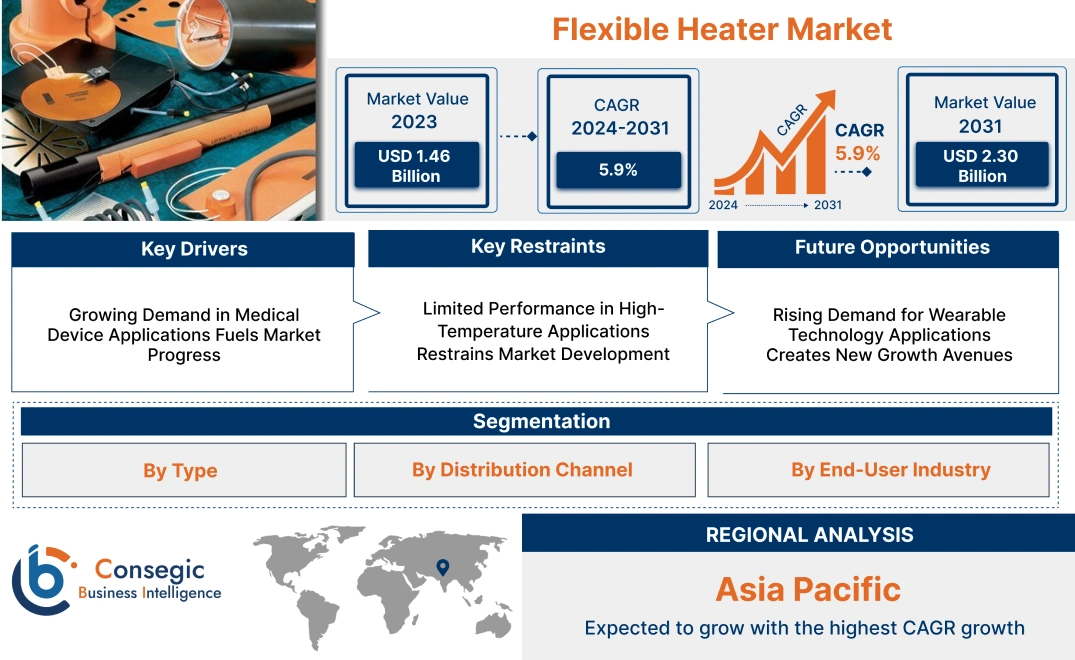- Summary
- Table Of Content
- Methodology
Flexible Heater Market Size:
Flexible Heater Market size is estimated to reach over USD 2.30 Billion by 2031 from a value of USD 1.46 Billion in 2023 and is projected to grow by USD 1.52 Billion in 2024, growing at a CAGR of 5.9% from 2024 to 2031.
Flexible Heater Market Scope & Overview:
A flexible heater is a thin, lightweight heating device designed to conform to the shape of the surface it is applied to, providing efficient and uniform heat distribution. Constructed using materials such as polyimide, silicone rubber, or polyester, these heaters integrate advanced heating elements like etched foil or wire wound circuits to deliver consistent performance across a variety of applications. Flexible heaters are commonly used in industries such as electronics, medical devices, automotive, and aerospace for temperature control, frost protection, and thermal management.
These heaters are customizable to fit complex geometries, offering versatility for use in components like sensors, battery packs, display panels, and industrial equipment. With features such as rapid heating, precise temperature control, and durability under harsh environmental conditions, flexible heaters are engineered for reliability in both low and high-temperature applications. Their compatibility with advanced monitoring systems further enhances their performance by allowing real-time temperature adjustments.
End-users of these heating solutions include manufacturers of electronic devices, automotive systems, and medical equipment, as well as industrial operators requiring effective and adaptable thermal solutions. Flexible heaters are integral to ensuring optimal performance, preventing damage from extreme temperatures, and maintaining operational efficiency in critical systems.
Flexible Heater MarketDynamics - (DRO) :
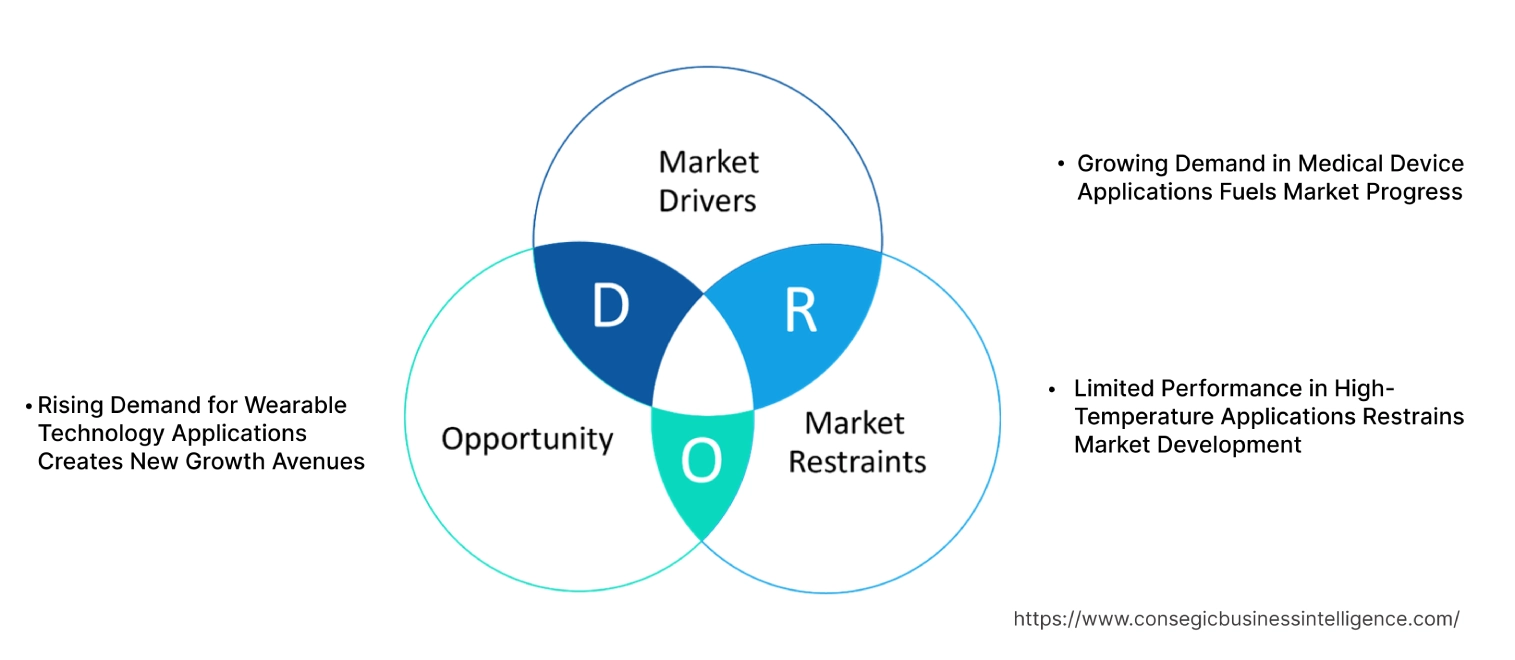
Key Drivers:
Growing Demand in Medical Device Applications Fuels Market Progress
The adoption of flexible heaters in medical device applications is rising due to their ability to provide precise and reliable temperature control in critical healthcare environments. These heaters are essential for diagnostic imaging equipment, such as MRI and CT scanners, where consistent thermal management ensures accurate results. Surgical instruments and patient warming systems, enable controlled heating to enhance patient safety and procedural efficiency. The increasing focus on minimally invasive surgeries and portable diagnostic tools is further boosting demand for compact and lightweight heating solutions.
Flexible heaters, with their adaptability to intricate designs and small form factors, meet these requirements effectively. Moreover, the growing adoption of wearable medical devices, such as glucose monitors and therapeutic wearables, relies on flexible heaters to maintain optimal functionality while ensuring patient comfort. As per the market analysis, the expanding range of medical applications underscores the critical role of flexible heaters in advancing modern healthcare solutions, contributing to the flexible heater market growth.
Key Restraints :
Limited Performance in High-Temperature Applications Restrains Market Development
Flexible heaters, while highly efficient in low-to-moderate temperature ranges, face significant limitations in high-temperature environments. The materials commonly used in their construction, such as polyimide, silicone, and etched foil, tend to degrade when exposed to extreme heat over prolonged periods. This degradation leads to reduced thermal efficiency, compromised performance, and shorter operational lifespans, making them less reliable for demanding applications. Industries like heavy industrial manufacturing, power generation, and aerospace, which often operate under high-temperature conditions, require heating solutions capable of withstanding extreme thermal stresses.
Flexible heaters struggle to meet these requirements, limiting their adoption in applications such as smelting, foundry operations, and high-temperature chemical processing. Furthermore, the need for specialized coatings or alternative materials to enhance their high-temperature tolerance adds to manufacturing complexity and cost, further restricting their deployment in industries prioritizing durability and cost-efficiency under harsh conditions, hampering the flexible heater market demand.
Future Opportunities :
Rising Demand for Wearable Technology Applications Creates New Growth Avenues
The growing adoption of wearable devices, such as fitness trackers, smartwatches, and healthcare monitoring systems, is driving demand for advanced heating solutions. Flexible heaters play a pivotal role in these applications by providing precise thermal management in compact and lightweight designs, which are essential for maintaining device functionality and user comfort. These heaters ensure consistent performance in wearables by preventing overheating and optimizing battery efficiency, which is critical for long-term usage.
In healthcare wearables, such as glucose monitors and digital therapeutic devices, flexible heaters support accurate temperature control for effective monitoring and treatment. Similarly, fitness and lifestyle wearables, enable efficient performance under varied environmental conditions. As wearable technology evolves to include advanced features like biometric sensors, AR/VR integration, and energy harvesting capabilities, the need for customized, energy-efficient, and durable heating solutions is growing, creating significant flexible heater market opportunities in this fast-expanding market.
Flexible Heater Market Segmental Analysis :
By Type:
Based on type, the market is segmented into Silicone Rubber-Based, Polyimide-Based, Polyester-Based, Mica-Based, and others.
The Silicone Rubber-Based segment held the largest revenue of 35.20% of the total flexible heater market share in 2023.
- Silicone rubber-based flexible heaters are widely used due to their excellent thermal conductivity, durability, and resistance to environmental factors, such as moisture and chemicals.
- These heaters are ideal for applications in industrial and medical devices, where precision heating and reliability are critical.
- The ability to operate efficiently at high temperatures and their lightweight design make them a preferred choice in automotive and aerospace systems.
- As per industry analysis, trends in precision heating solutions are driving the adoption of silicone rubber-based heaters in emerging markets, contributing to flexible heater market expansion.
The Polyimide-Based segment is expected to register the fastest CAGR during the forecast period.
- Polyimide-based flexible heaters are known for their lightweight construction, high dielectric strength, and resistance to chemicals, making them suitable for compact and sensitive electronic devices.
- These heaters are increasingly integrated into wearables, sensors, and medical devices due to their thin profile and efficient heat distribution.
- The rapid growth of this segment is supported by advancements in electronics manufacturing and the rising focus on miniaturized heating solutions.
- Trends indicate that polyimide-based heaters are gaining popularity in industries requiring precise and uniform heating further driving the flexible heater market growth.
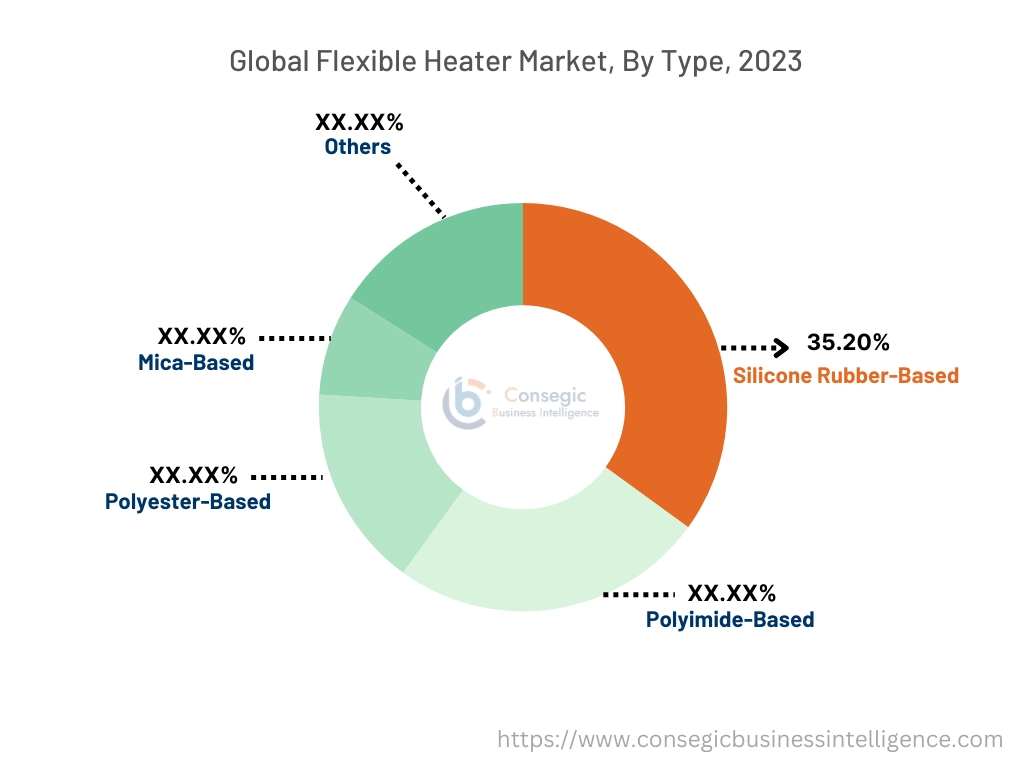
By Distribution Channel:
Based on the distribution channel, the market is segmented into Online and Offline channels.
The Offline segment accounted for the largest revenue of the total flexible heater market share in 2023.
- Offline distribution channels, including direct sales and partnerships with distributors, are preferred by industries requiring custom solutions and technical support.
- These channels offer the advantage of physical inspection and direct communication with manufacturers, ensuring product reliability and customization.
- Industrial and healthcare sectors predominantly rely on offline channels for bulk orders and tailored flexible heating systems.
- As per flexible heater market analysis, the dominance of offline channels is supported by trends emphasizing the importance of personalized service and technical assistance in high-stakes applications.
The Online segment is projected to grow at the fastest CAGR during the forecast period.
- Online platforms provide convenience and accessibility, enabling businesses to source flexible heaters quickly and efficiently.
- E-commerce channels offer a wide variety of products, catering to small-scale buyers in consumer electronics and DIY projects.
- The rapid adoption of digital procurement platforms is driving the growth of online distribution channels, especially in regions with expanding internet penetration.
- Market analysis highlights the increasing preference for online platforms due to competitive pricing, easy comparison, and faster delivery times, fueling the flexible heater market demand.
By End-User Industry:
Based on the end-user industry, the market is segmented into Healthcare, Consumer Electronics, Automotive, Aerospace, Industrial, and Others.
The Healthcare segment held the largest revenue share in 2023.
- Flexible heaters are extensively used in medical devices, such as blood analyzers, patient warming systems, and diagnostic equipment, to ensure precise temperature control.
- The healthcare industry's focus on enhancing patient care and operational efficiency is driving the adoption of advanced heating technologies.
- Trends in minimally invasive devices and wearable medical technologies are contributing to the growth of flexible heaters in this segment.
- As per flexible heater market trends, the dominance of this segment reflects its critical role in supporting temperature-sensitive medical applications.
The Consumer Electronics segment is expected to register the fastest CAGR during the forecast period.
- Flexible heaters are increasingly integrated into devices like smartphones, tablets, and wearables to manage heat dissipation and improve device performance.
- The rise in smart home devices and IoT-enabled electronics is further fueling the adoption of compact and efficient heating solutions.
- Market analysis indicates that the consumer electronics segment is benefiting from innovations in flexible heater design, enabling better thermal management in compact devices.
- As per flexible heater market analysis, the rapid growth of this segment is attributed to the increasing consumer focus on high-performance and reliable electronic products.
Regional Analysis:
The regions covered are North America, Europe, Asia Pacific, the Middle East and Africa, and Latin America.
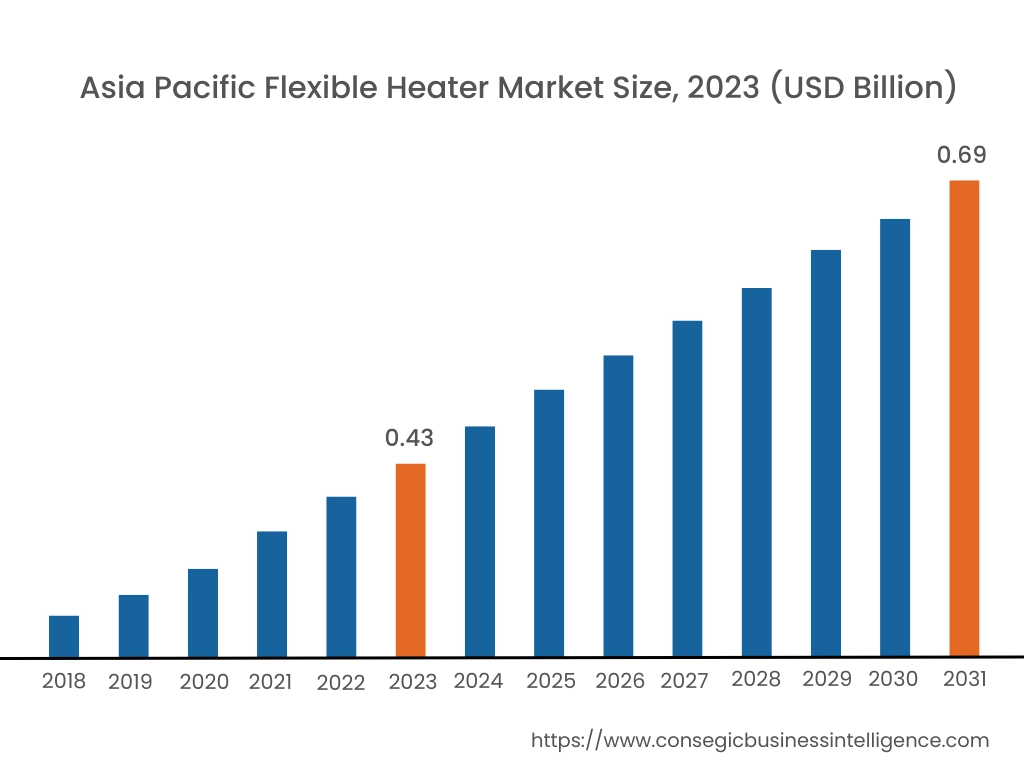
Asia Pacific region was valued at USD 0.43 Billion in 2023. Moreover, it is projected to grow by USD 0.45 Billion in 2024 and reach over USD 0.69 Billion by 2031. Out of these, China accounted for the largest share of 42.6% in 2023. The Asia-Pacific region is experiencing rapid expansion in the flexible heater market, driven by industrialization and the growth of the electronics manufacturing sector. Countries like China, Japan, and South Korea are leading in the production and application of flexible heaters, particularly in the consumer electronics and automotive industries. The trend towards automation and the increasing demand for efficient heating solutions in manufacturing processes are notable, significantly creating flexible heater market opportunities.
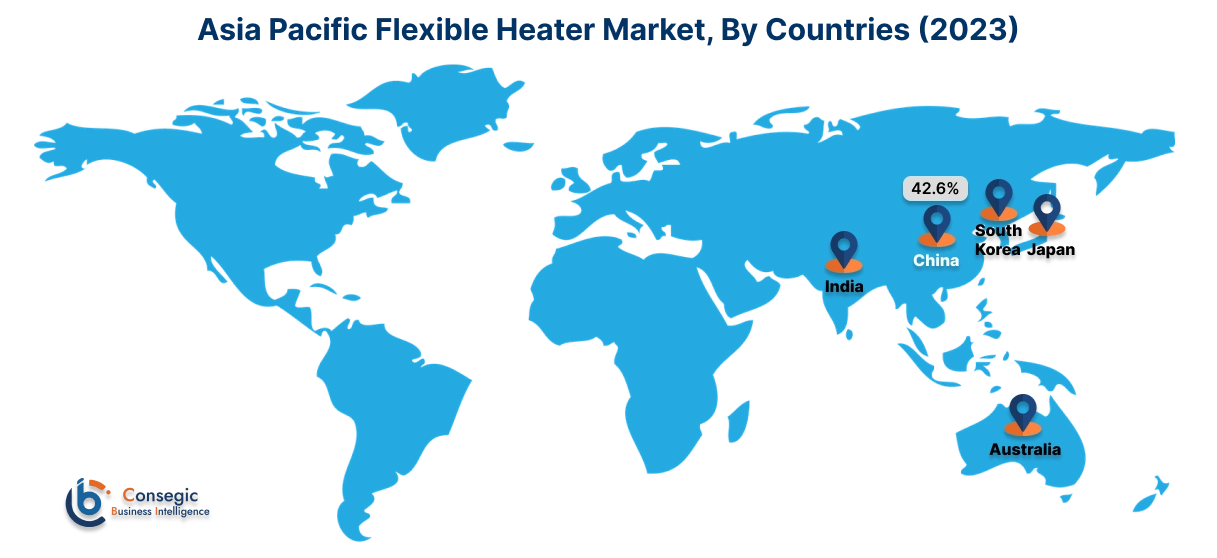
North America is estimated to reach over USD 0.76 Billion by 2031 from a value of USD 0.48 Billion in 2023 and is projected to grow by USD 0.50 Billion in 2024. In North America, the market is characterized by significant adoption across sectors such as electronics, automotive, and medical devices. The region's emphasis on technological innovation and the presence of key industry players contribute to the widespread utilization of flexible heaters. The trend towards miniaturization in electronics and the increasing integration of flexible heaters in medical equipment underscores the flexible heater market expansion.
Europe's market is marked by a strong focus on energy efficiency and sustainability. Industries such as automotive and aerospace are increasingly incorporating flexible heaters to enhance performance and reduce energy consumption. As per flexible heater market trends, the region's commitment to environmental regulations drives the adoption of advanced heating solutions.
In the Middle East & Africa, the flexible heater market is gradually developing, with applications primarily in the oil & gas and industrial sectors. The need for reliable heating solutions in harsh environments drives the adoption of flexible heaters.
Latin America's flexible heater market is emerging, with growing applications in the food & beverage and automotive industries. The trend toward modernization of industrial processes and increasing investments in manufacturing sectors contribute to market development.
Top Key Players & Market Share Insights:
The Flexible Heater market is highly competitive with major players providing products and services to the national and international markets. Key players are adopting several strategies in research and development (R&D), product innovation, and end-user launches to hold a strong position in the global Flexible Heater market. Key players in the Flexible Heater industry include -
- NIBE Industrier AB (Sweden)
- Honeywell International Inc. (USA)
- Omega Engineering Inc. (USA)
- Watlow Electric Manufacturing Company (USA)
- Smiths Group plc (UK)
- Chromalox, Inc. (USA)
- Rogers Corporation (USA)
- Minco Products, Inc. (USA)
- Zoppas Industries (Italy)
- All Flex Flexible Circuits (USA)
Flexible Heater Market Report Insights :
| Report Attributes | Report Details |
| Study Timeline | 2018-2031 |
| Market Size in 2031 | USD 39.23 Billion |
| CAGR (2024-2031) | 22.3% |
| By Type |
|
| By Distribution Channel |
|
| By End-User Industry |
|
| By Region |
|
| Key Players |
|
| North America | U.S. Canada Mexico |
| Europe | U.K. Germany France Spain Italy Russia Benelux Rest of Europe |
| APAC | China South Korea Japan India Australia ASEAN Rest of Asia-Pacific |
| Middle East and Africa | GCC Turkey South Africa Rest of MEA |
| LATAM | Brazil Argentina Chile Rest of LATAM |
| Report Coverage |
|
Key Questions Answered in the Report
How big is the Flexible Heater Market? +
Flexible Heater Market size is estimated to reach over USD 2.30 Billion by 2031 from a value of USD 1.46 Billion in 2023 and is projected to grow by USD 1.52 Billion in 2024, growing at a CAGR of 5.9% from 2024 to 2031.
What specific segmentation details are covered in the Flexible Heater Market report? +
The Flexible Heater Market report includes segmentation details by type (Silicone Rubber-Based, Polyimide-Based, Polyester-Based, Mica-Based, Others), distribution channel (Online, Offline), end-user industry (Healthcare, Consumer Electronics, Automotive, Aerospace, Industrial, Others), and region (Asia-Pacific, Europe, North America, Latin America, Middle East & Africa).
Which is the fastest-growing segment in the Flexible Heater Market? +
The Polyimide-Based segment is expected to register the fastest CAGR during the forecast period. Polyimide-based flexible heaters are increasingly used in wearables, sensors, and medical devices due to their thin profile, high dielectric strength, and efficient heat distribution.
Who are the major players in the Flexible Heater Market? +
The major players in the Flexible Heater Market include NIBE Industrier AB (Sweden), Honeywell International Inc. (USA), Omega Engineering Inc. (USA), Watlow Electric Manufacturing Company (USA), Smiths Group plc (UK), Chromalox, Inc. (USA), Rogers Corporation (USA), Minco Products, Inc. (USA), Zoppas Industries (Italy), and All Flex Flexible Circuits (USA).
